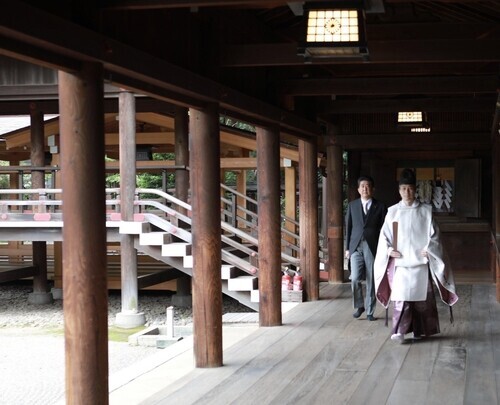hankyoreh
Links to other country sites 다른 나라 사이트 링크
Abe visits Yasukuni Shrine only 3 days after resigning

Only three days after stepping down as prime minister of Japan, Shinzo Abe paid a visit to the Yasukuni Shrine, where a number of Class A war criminals from World War II are enshrined.
On the morning of Sept. 19, Abe wrote on Twitter that he’d “informed the spirits that [he’d] resigned as prime minister on Sept. 16” and posted a picture of him walking through the grounds of the shrine, in Tokyo’s Chiyoda Ward. He also wrote “Shinzo Abe, former prime minister,” on the visitor’s log at the shrine.
This was the first time Abe had visited Yasukuni Shrine in six years and eight months, since December 2013. Abe hadn’t visited the shrine during his first term as prime minister; the previous prime minister to pay his respects at the shrine while in office was Junichiro Koizumi, seven years earlier.
As a facility that venerates the spirits of those who died in the various wars waged by Japan in the early modern era, Yasukuni Shrine played a considerable role in Japan’s militarism. Close to 2.5 million people are currently enshrined there, including 14 individuals classified as Class A war criminals after World War II. Koreans who were drafted to fight or work in the Japanese military are also inscribed on the shrine’s list of names.
A visit to Yasukuni Shrine by the Japanese prime minister arouses sharp criticism from Japan’s neighbors. When Abe visited the shrine in 2013, South Korea and China were vocal in their criticism, while the US and the EU also issued statements expressing “disappointment” and “regret.”
Following that incident, Abe refrained from personally visiting Yasukuni Shrine. Instead, Abe sent an offering under the name “Shinzo Abe, head of the Liberal Democratic Party,” to ceremonies each spring and fall and on Aug. 15, when Japan commemorates the end of World War II.
Abe may no longer be the sitting prime minister, but he remains a lawmaker in the Diet and still wields immense political influence even after resigning his premiership following a relapse of ulcerative colitis, a chronic condition. In an interview with Japanese newspaper the Yomiuri Shimbun on Sept. 18, Abe hinted that he would like to serve as a special diplomatic envoy under the administration of Yoshihide Suga, the new prime minister.
Seiichi Eto, a right-wing figure who served as Minister of State for Okinawa and Northern Territories Affairs during Abe’s second premiership, described Abe’s visit to Yasukuni Shrine on Sunday as being “a very sober and splendid decision.” Eto is the person who told South Korean lawmakers who visited Japan in August 2019 that he’d only “been to Korea once” despite being 71 years old and that “a lot of Japanese use to go to Korea to visit the prostitutes there” but that he hadn’t gone because he “didn’t like that kind of thing.”
Fumio Kishida, head of the Liberal Democratic Party’s Policy Research Council, defended Abe’s decision to visit the shrine as being a “matter of the heart” and said it “shouldn’t be treated as a diplomatic issue.”
“The government expresses its deep concern and regret for the fact that Shinzo Abe paid his respects at the Yasukuni Shrine, a symbol of efforts to whitewash Japan’s colonial looting and wars of aggression, so soon after stepping down as prime minister,” South Korea’s Ministry of Foreign Affairs said on Sept. 19.
By Cho Ki-weon, staff reporter
Please direct comments or questions to [english@hani.co.kr]

Editorial・opinion
![[Column] Has Korea, too, crossed the Rubicon on China? [Column] Has Korea, too, crossed the Rubicon on China?](https://flexible.img.hani.co.kr/flexible/normal/500/300/imgdb/original/2024/0419/9317135153409185.jpg) [Column] Has Korea, too, crossed the Rubicon on China?
[Column] Has Korea, too, crossed the Rubicon on China?![[Correspondent’s column] In Japan’s alliance with US, echoes of its past alliances with UK [Correspondent’s column] In Japan’s alliance with US, echoes of its past alliances with UK](https://flexible.img.hani.co.kr/flexible/normal/500/300/imgdb/original/2024/0419/2317135166563519.jpg) [Correspondent’s column] In Japan’s alliance with US, echoes of its past alliances with UK
[Correspondent’s column] In Japan’s alliance with US, echoes of its past alliances with UK- [Editorial] Does Yoon think the Korean public is wrong?
- [Editorial] As it bolsters its alliance with US, Japan must be accountable for past
- [Guest essay] Amending the Constitution is Yoon’s key to leaving office in public’s good graces
- [Editorial] 10 years on, lessons of Sewol tragedy must never be forgotten
- [Column] A death blow to Korea’s prosecutor politics
- [Correspondent’s column] The US and the end of Japanese pacifism
- [Guest essay] How Korea turned its trainee doctors into monsters
- [Guest essay] As someone who helped forge Seoul-Moscow ties, their status today troubles me
Most viewed articles
- 1[Column] The clock is ticking for Korea’s first lady
- 2Samsung barricades office as unionized workers strike for better conditions
- 3After 2 months of delayed, denied medical care, Koreans worry worst may be yet to come
- 4[Correspondent’s column] In Japan’s alliance with US, echoes of its past alliances with UK
- 5[Column] Has Korea, too, crossed the Rubicon on China?
- 6Hong Se-hwa, voice for tolerance whose memoir of exile touched a chord, dies at 76
- 7[Editorial] When the choice is kids or career, Korea will never overcome birth rate woes
- 8Constitutional Court rules to disband left-wing Unified Progressive Party
- 9Nearly 1 in 5 N. Korean defectors say they regret coming to S. Korea
- 10‘Right direction’: After judgment day from voters, Yoon shrugs off calls for change